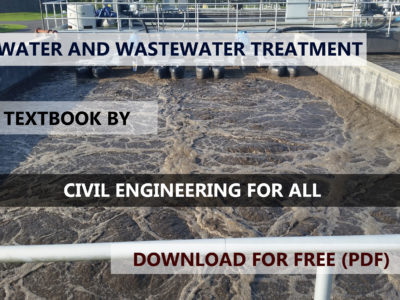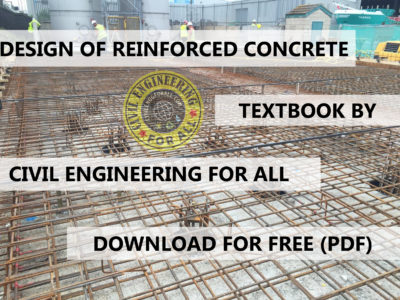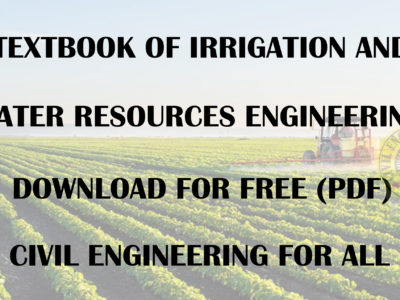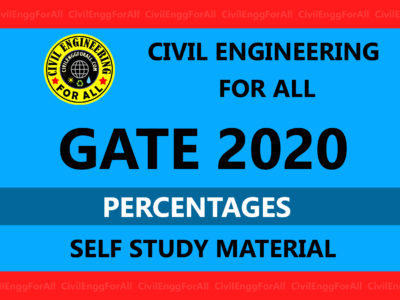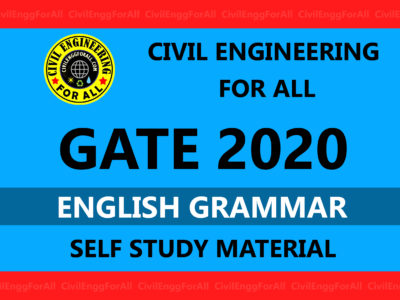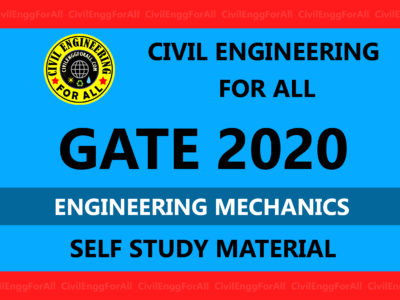
CONTENTS
- Soil Mechanics
- Soil Classification
- Index Properties
- Mineral Contents of Soil
- Permeability
- Seepage
- Effective Stress Principle
- Compaction
- Compressibility and Consolidation
- Shear Strength

SOILS
All soils consists of solid particles assembled in a relatively loose packing. The voids between the particles may be filled completely with water (fully saturated soils) or may be partly filled with water and partly with air (partly saturated soils) or fully dried soil i.e. voids are filled with air (Saturated = 0).
Classification of Soils Based on the Basis of Origin, Types of Soils
(i) Residual soil – Soil formed by weathering of parent rock and still occupies the position of the rock from which it has been formed, is called residual soil.
(ii) Transported soil – Soil transported from its place of origin by wind, water, ice or some other agency, and has been re-deposited, is called transported soil.
Classification of transported soils:
Alluvial deposits – soils that have been deposited from suspension in running water
Lacustrine deposits – soils that have been deposited from suspension in still fresh water of lakes
Marine deposits – soils that have been deposited from suspension in sea water
Aeolin deposits – soils that have been transported by wind
Glacial deposits – soils that have been transported by ice
Coefficient of Uniformity and Coefficient of Curvature

The particle size distribution of a soil is presented as a curve on a semi-logarithmic plot, the ordinate being the percentage by weight of particles smaller than the size given by abscissa. The flatter the distribution curve, larger the range of particles sizes in the soil. The steeper the curve the smaller the size range. A coarse-grained soil is described as well graded if there is no excess of particles in any size range if no intermediate sizes are lacking. In general a well graded soil is represented by a smooth concave distribution curve. A coarse grained soil is described as poorly graded.
(i) Uniform soil – If a high proportion of the particles have sizes within narrow limits.
(ii) Gap-graded soil – If particles of both large and small sizes are present with a relatively low proportion of particles of intermediate sizes.
Particle size is represented on a logarithmic scale so that two soils having the same degree of uniformity are represented by curve of the same shape regardless of their position on the particle size distribution. The particle size corresponding to any specified value on the “percentage smaller” scale can be read from the particle size distribution curve. The size such that 10% of the particles are smaller than that size is denoted by D10 is defined as the effective size. The general slope and shape of the distribution curve can be described by means of the coefficient of uniformity (Cu) and the coefficient of curvature (Cc) defined as follows:
Cu = Coefficient of uniformity = D60/D10
Cc = Coefficient of curvature = D302/D60.D10
Uniformly graded soil will have its coefficient of uniformity (Cu) of less than 2.0. Sands with a value of Cu of 6 or more are well graded. Gravels with a value of Cu of 4 or more are well graded. A well graded soil will have its coefficient of curvature (Cc) lies between 1 and 3.
IES MASTER CIVIL ENGINEERING GATE STUDY MATERIALS PDF: CLICK HERE
ACE ACADEMY CIVIL ENGINEERING GATE STUDY MATERIALS PDF: CLICK HERE
INDEX PROPERTIES

Consistency of clay and other cohesive soils is greatly influenced by water content of the soil. The term consistency denotes the degree of stiffness of soil as soft, medium, firm, stiff. It indicates the relative case with which a soil can be deformed. If a clay slurry is allowed to dry slowly, it will pass from liquid state to plastic state and semi-solid and finally it reaches the solid state.
Consistency Limits or Atterberg Limits – Atterberg divided the range from liquid to solid state in four states of consistency
- Liquid state
- Plastic state
- Semi-solid state
- Solid state.
MINERAL CONTENTS OF SOIL
Rock fragments can be reduced by mechanical means to a limiting size of about 0.002 mm so that a soil containing particles above this size has a mineral content similar to the parent rock from which it was created. For the production of particles smaller than 0.002 mm some form of chemical action is generally necessary before breakdown can be achieved. Such particles, although having a chemical content similar to the parent rock, have a different crystalline structure and are called clay particles.
Classification of Clay Minerals
The minerals comprising a clay are invariably the result of the chemical weathering of rock particles and are hydrates of aluminium, iron and magnesium silicate generally combined in such a manner as to create sheet like structures only a few molecules thick. These sheets are built from two basic units the tetrahedral unit silica and the octahedral unit of the hydroxide of aluminium, iron and magnesium. The main dimensions of clay particles is usually less than 0.002 mm and the different types of minerals have been created from the manner in which these structures were stacked together. Below are the principal clay minerals
Kaolinite – It is less prone to change in volume due to moisture. So its presence in soil reflects a capable soil for Engineering structures.

Montmorillonite – It causes major change in volume when contacted to water. Such large volume expansion of this mineral in presence of water renders it unsuitable for engineering applications without taking special measures.

Illite

SEEPAGE – Percolation of water through the soil pores under an energy gradient is called seepage. The pressure exerted on the soil due to seepage of water is called seepage force or seepage pressure. Seepage problem occurs in all earthen dams, retaining walls and foundations on permeable soil.
Flowlines – The paths which water particle follow in the course of seepage are called flow lines. Water flows from points of high head to points of low head, and makes smooth curves representing the paths followed by moving water particles.
Equipotential lines – As the water moves along the flow it experiences a continuous loss of head. If we can obtain the head causing flow at points along a flow line, then by joining up points of equal potential we obtain a second set of line called equipotential lines.
Hydraulic gradient – The potential drop between two adjacent equipotential lines divided by the distance between them is called the hydraulic gradient. It attains a maximum along a path normal to the equipotentials and in isotropic soil the flow follows the path of the steepest gradients, so that flow lines cross equipotential lines at right angles.
Flowpath – The space between adjacent flow lines is called flow path or flow channel.
Piezometric level – At all points along an equipotential line, the water would rise in a piezometric tube to a certain elevation known as piezometric level.
Flow Nets – The flow of water through a soil can be represented graphically by a flow net, a form of curvilinear net made up of a set of flow line intersected by a set of equipotential lines.
Properties of Flownet
- Flowlines and equipotential lines must intersect at right angles to each other.
- Areas (field) bounded by flow lines and equipotential lines should form approximate squares.
- Flow nets must satisfy the boundary conditions of flow field.
- Quantity of water flowing through each flow channel is the same.
- Potential drop in any two adjacent equipotential lines is equal (Total head loss/Number of fields)
- Flow lines and equipotential lines are smooth curves.
Two Dimensional Flow
To determine quantity of water flowing through saturated soil mass and the distribution of water pressure by the theory of flow of fluid through porous medium, the following assumptions were made.
- Soil mass is homogeneous and isotropic.
- The soil and water are incompressible.
- The flow is assumed to be laminar so that Darcy’s law is valid.
- Quantity of water stored in soil pores is constant so that steady flow conditions have been established.
Quick Sand
Quick sand is not a type of sand but it is a flow condition existing in fine sand when the flow takes place in upward direction. Due to upward flow, the seepage pressure acts in the upward direction and hence the effective pressure is reduced. When the soil pressure and the seepage pressure becomes equal, the effective stress is reduced to zero. In such a case, cohesionless soil losses its shear strength and soil particles have a tendency to move up in the direction of flow. The condition at which the soil particles are unstable or agitated is called quick sand.
Critical Hydraulic Gradient (ic)
Hydraulic gradient at the critical condition when the soil particles just begin to move is called critical hydraulic gradient. When the exit gradient is equal to or greater than critical hydraulic gradient, the soil is said to be in quick condition. Since critical hydraulic gradient depends on the specific gravity and void ratio of the soil, such critical condition is more common in uniform sands and silts with high void ratios.
Seepage Pressure (ps)
It can be defined as the pressure exerted by water on the soil through which it percolates. The total seepage force transmitted to the soil mass (Fs) can be easily obtained by multiplying the seepage pressure (ps) by the total cross-sectional area of the soil mass (A). The seepage pressure always acts in the direction of flow. In case of uniform flow conditions, it can be assumed to spread uniformly through the volume of the soil.
Piping
The direct result of quick sand condition is that the soil particles are carried continuously along with the flowing water and the pipes are created at the downstream side, the undermining of foundation and increasing the loss due to seepage. This effect is called piping. This phenomenon is common in dams.
COMPACTION
It is defined as the process of increasing unit weight of soil by forcing the soil solids to move closer due to the expulsion of air from the voids and this is accomplished by rolling or tamping.

Compaction Theory
This theory gives a relationship between soil density, water content and compactive effort applied on a specimen when water (moisture) is added to a dry soil, the soil grains get surrounded by a film of absorbed water. If more water is added, this film becomes thicker, and soil grains surrounded by such films, can slide over each other more easily. The grains thus becomes capable to occupy closer spacing more easily on application of external loading. The water thus acts only as a lubricant in the compaction process, and a closer packing of soil grains is achieved on rolling, by the expulsion of air from the voids. If more water is continued to be added, then a stage comes when water becomes excess, and starts occupying the space which otherwise could have been occupied by soil grains under compaction. Evidently, water then starts hindering the closer packing of grains. In the limiting stage, there occurs a particular amount of water, which causes maximum lubrication, without becoming excess to cause hinderance in compaction by occupying space for its own molecules. This limiting moisture, which is most useful to compaction, is called the optimum moisture content (OMC).
At OMC, maximum density or unit weight obtained is called proctor density. Field examples for use of OMC: Core of earthen dam – kept wet side of optimum m.c. Side slopes of earthen dam – kept dry side of OMC
Relative Compaction
The results of laboratory compaction are not directly applicable to field compaction because the equipment used in field is different as well as no lateral confinement is possible in field compaction. It is very difficult to obtain minimum compaction in the field. The dry density achieved by field compaction expressed as a percentage of the maximum dry density in a particular laboratory test is called relative compaction.
Factors Affecting Compaction

- Water content of soil: At low moisture content, the cohesion is more and the particles do not move easily when energy is supplied and hence the high air void and low density. The increase in water content results in increase in density (inter particle repulsion is more) till an OMC is reached. After OMC is reached further addition of water reduces the dry density because the extra water displace the soil particle occupying that space.
- Mode and type of compaction: The minimum dry density and OMC depends upon the amount of energy supplied to the soil. The increase in compactive energy results in an increase in maximum dry density and decrease in optimum moisture content.
- Type of soil: The coarse grained soil attains a higher density and lower OMC as compared to fine grain soils for the same amount of energy transmitted. Because the specific surface of fine grain particles is more and they have more affinity towards water because of particles having negative charge.
- Addition of admixtures: The compaction properties of soil can often be improved by the use of admixtures. Some of the more widely used admixtures are lime and cement. (5) Amount of compact i on: At a water content less than the optimum, the effect of increased compaction is more predominant. At a water content more than optimum, the effect of increased compaction is not significant as volume of air voids becomes constant.
MADE EASY CIVIL ENGINEERING GATE NOTES PDF: CLICK HERE
ACE ACADEMY CIVIL ENGINEERING GATE NOTES PDF: CLICK HERE
Engineering Properties of Compacted Soils
Shear Strength
- Shear strength will increase with increasing compactive effort until a critical degree of saturation is reached and then decrease rapidly with further increase in water content.
- The sample compacted on dry side of optimum will exhibit more strength than soils compacted on wet side of optimum.
- On the wet side of optimum, the static compaction tends to cause more shear strength than kneading compaction.
Permeability
The permeability of a soil decreases with an increase in water content on the dry side of the optimum water content. There is an improved orientation of the particles and a corresponding reduction in size of voids. The minimum permeability occurs at or slightly above the optimum water content. After that stage, the permeability slightly increase, but it always remains much less than on the dry side of the optimum. The slight increase in the permeability occurs because the effect of the decrease in the dry unit weight is more pronounced than the effect of the improved orientation. If the compactive effort is increased, the permeability of the soil decreased due to increased unit dry weight and better orientation of particles.
Compressibility and volume change
- Soil compacted on dry side of optimum tends to shrink less and swell more as compared to soil compacted on wet side of optimum.
- Type of compaction plays major role when samples compacted on wet side of optimum. Kneading compaction exhibits higher compressibility than those with other methods.
- The compressibility of a compacted cohesive soil increases with an increase in degree of saturation and with a decrease in dry density.
- Compressibility of compacted cohesive soil increase with an increase in liquid limit.
SOIL MECHANICS CIVIL ENGINEERING GATE 2020 STUDY MATERIAL FREE DOWNLOAD PDF
DOWNLOAD LINK : CLICK HERE
PASSWORD : CivilEnggForAll
NOTE: The MCQ and previous years questions along with solutions of Soil Mechanics will be posted along with the Foundation Engineering GATE 2020 CivilEnggForAll Study Material
OTHER USEFUL BOOKS
- CIVIL ENGINEERING TEXTBOOKS WITH DOWNLOAD LINKS
- IES MASTER CIVIL ENGINEERING GATE STUDY MATERIALS PDF
- ACE ACADEMY CIVIL ENGINEERING GATE STUDY MATERIALS PDF
- RAJASTHAN STAFF SELECTION BOARD (RSSB) JUNIOR ENGINEER DIPLOMA CIVIL ENGINEERING EXAM 2022 – HINDI & ENGLISH MEDIUM SOLVED PAPER – FREE DOWNLOAD PDF (CivilEnggForAll.com)
- ISRO TECHNICAL ASSISTANT EXAM 2022 – CIVIL ENGINEERING – HINDI & ENGLISH MEDIUM – SOLVED PAPER – FREE DOWNLOAD PDF (CivilEnggForAll.com)
- MADHYA PRADESH PUBLIC SERVICE (MPPSC) COMMISSION – ASSISTANT ENGINEER EXAM – MPPSC AE 2021 CIVIL ENGINEERING – SOLVED PAPER WITH EXPLANATIONS – PDF FREE DOWNLOAD
- BIHAR PUBLIC SERVICE COMMISSION (BPSC) ASSISTANT ENGINEER EXAM – 2022 – CIVIL ENGINEERING – SOLVED PAPER – FREE DOWNLOAD PDF (CivilEnggForAll.com)
- ODISHA PUBLIC SERVICE COMMISSION – OPSC AEE PANCHAYATI RAJ EXAM 2021 – SOLVED PAPER WITH EXPLANATION – FREE DOWNLOAD PDF








